MaryAnn Bernal's Blog, page 229
October 13, 2014
'Flying Coffin' WWII Wreck Found
By Rossella Lorenzi

The heavy bomber Consolidated B-24 Liberator, known by its crews as the “Flying Coffin.”
Credit: Mario Di SorteA forgotten story of death and survival during wartime has been brought to light after 70 years as local people unearthed the remains of an American World War II aircraft known as the “Flying Coffin.”
Found in the forests of Selva del Lamone, a natural reserve near the town of Farnese, Viterbo, in central Italy, the wreck remains were identified as belonging to the heavy bomber Consolidated B-24 Liberator.
B-24s are recorded as having dropped over 630,000 tons of bombs during World War II and were the most heavily produced American aircraft.
The four-engine aircraft was notorious among aircrews. Officially designated the “Liberator,” the square shaped B-24 could easily turn into a death trap. It was hard to fly with its stiff and heavy controls, and so earned its name by its crews as the “Flying Coffin.”
Liberators had only one exit near the tail, making it almost impossible for the crew to reach the rear from the flight deck when wearing a parachute.
WWII Dogfight Evidence Found in Italy
According to historian Mario Di Sorte, the wreckage fragments found in Selva del Lamone belong to a B-24 ‘H’ model that operated within the 15th Air Force, 454th Bomb Group, 736th Bomb Squadron from San Giovanni, near Foggia in southern Italy.
“We were able to fully reconstruct its last flight, unveiling a drama which involved South African escapees, Italian civilians and U.S. pilots,” Di Sorte told Discovery News.
The B-24H took off from San Giovanni on March 3, 1944 for a bombing mission to Canino airport, south west of Lake Bolsena. It was one of the 277 bombers — all B-17 “Flying Fortress” and B-24 Liberators — taking off from airfields in Puglia to bomb bridges, train stations and airports controlled by the Germans.
The B-24H was part of an 18-bomber formation that dropped some 25 tons of bombs on the Canino airport, where the Focke Wulf 190 fighters led by German Luftwaffe flying ace Erich Honagen operated.
“Weather conditions and clouds prevented accurate bombing. Only half of the bombers actually dropped their loads, in many cases missing the main target area,” Di Sorte said.
Photos: WWII Wreck Reveals Wartime Romance
As two German fighters attacked the B-24H and its 10-man crew led by lieutenant William J. Goodwin Jr., only two men managed to parachute: sergeant gunner Wallace H. Cleveland and sergeant tail gunner John M. Ashby.
They were the only survivors of the “Flying Coffin.”
The B-24H exploded before crashing. It split in three parts, leaving the Italian civilians who came to the crash site with a horrifying scene of death.
“Carbonized bodies were scattered around the wreckage, a body was hanging from a tree with his parachute, while lieutenant William J. Goodwin was seen laying on the ground wearing the oxygen mask with bandages stuffed inside,” Di Sorte said.
Seriously injured, sergeant Cleveland parachuted away from the crash and was captured by the Germans, ending up in a prison camp in Germany.
WWII Fighter Plane Recovered: BIG PIC
Sergeant Ashby was helped by the local family Sabatini along with two South African soldiers. They had escaped from a prison camp in Italy and were hiding themselves in caves owned by the Sabatinis.
While Asby was later captured by the Germans, also ending up in a prison camp, the South African soldiers met a terrible fate.
“Bobby” Robert Carter of the South African Engineer Corps and “Alfred” F.J.Crinall of the Rand Light Infantry South African Forces were arrested in the town of Farnese by the Germans on June 4, 1944.
“They were tortured for two days, forced to dig their own pit and then shot dead,” Di Sorte said.
The wreckage fragments will go on display in the Selva del Lamone natural reserve by the end of the year. Along with commemorative panels, they will recount the story of the American and South African soldiers
Live Science


The heavy bomber Consolidated B-24 Liberator, known by its crews as the “Flying Coffin.”
Credit: Mario Di SorteA forgotten story of death and survival during wartime has been brought to light after 70 years as local people unearthed the remains of an American World War II aircraft known as the “Flying Coffin.”
Found in the forests of Selva del Lamone, a natural reserve near the town of Farnese, Viterbo, in central Italy, the wreck remains were identified as belonging to the heavy bomber Consolidated B-24 Liberator.
B-24s are recorded as having dropped over 630,000 tons of bombs during World War II and were the most heavily produced American aircraft.
The four-engine aircraft was notorious among aircrews. Officially designated the “Liberator,” the square shaped B-24 could easily turn into a death trap. It was hard to fly with its stiff and heavy controls, and so earned its name by its crews as the “Flying Coffin.”
Liberators had only one exit near the tail, making it almost impossible for the crew to reach the rear from the flight deck when wearing a parachute.
WWII Dogfight Evidence Found in Italy
According to historian Mario Di Sorte, the wreckage fragments found in Selva del Lamone belong to a B-24 ‘H’ model that operated within the 15th Air Force, 454th Bomb Group, 736th Bomb Squadron from San Giovanni, near Foggia in southern Italy.
“We were able to fully reconstruct its last flight, unveiling a drama which involved South African escapees, Italian civilians and U.S. pilots,” Di Sorte told Discovery News.
The B-24H took off from San Giovanni on March 3, 1944 for a bombing mission to Canino airport, south west of Lake Bolsena. It was one of the 277 bombers — all B-17 “Flying Fortress” and B-24 Liberators — taking off from airfields in Puglia to bomb bridges, train stations and airports controlled by the Germans.
The B-24H was part of an 18-bomber formation that dropped some 25 tons of bombs on the Canino airport, where the Focke Wulf 190 fighters led by German Luftwaffe flying ace Erich Honagen operated.
“Weather conditions and clouds prevented accurate bombing. Only half of the bombers actually dropped their loads, in many cases missing the main target area,” Di Sorte said.
Photos: WWII Wreck Reveals Wartime Romance
As two German fighters attacked the B-24H and its 10-man crew led by lieutenant William J. Goodwin Jr., only two men managed to parachute: sergeant gunner Wallace H. Cleveland and sergeant tail gunner John M. Ashby.
They were the only survivors of the “Flying Coffin.”
The B-24H exploded before crashing. It split in three parts, leaving the Italian civilians who came to the crash site with a horrifying scene of death.
“Carbonized bodies were scattered around the wreckage, a body was hanging from a tree with his parachute, while lieutenant William J. Goodwin was seen laying on the ground wearing the oxygen mask with bandages stuffed inside,” Di Sorte said.
Seriously injured, sergeant Cleveland parachuted away from the crash and was captured by the Germans, ending up in a prison camp in Germany.
WWII Fighter Plane Recovered: BIG PIC
Sergeant Ashby was helped by the local family Sabatini along with two South African soldiers. They had escaped from a prison camp in Italy and were hiding themselves in caves owned by the Sabatinis.
While Asby was later captured by the Germans, also ending up in a prison camp, the South African soldiers met a terrible fate.
“Bobby” Robert Carter of the South African Engineer Corps and “Alfred” F.J.Crinall of the Rand Light Infantry South African Forces were arrested in the town of Farnese by the Germans on June 4, 1944.
“They were tortured for two days, forced to dig their own pit and then shot dead,” Di Sorte said.
The wreckage fragments will go on display in the Selva del Lamone natural reserve by the end of the year. Along with commemorative panels, they will recount the story of the American and South African soldiers
Live Science

Published on October 13, 2014 16:15
Hermes Mosaic Unearthed at Ancient Greek Tomb
 By Megan Gannon
By Megan GannonThis mosaic is the most intricate yet discovered at the Kasta Hill burial complex.
Credit: Greek Ministry of Culture
An elaborate and colorful mosaic showing the Greek god Hermes leading a man to the underworld has been uncovered in a vast tomb from the era of Alexander the Great, Greek archaeologists announced.
The figurative artwork spans the surface of an antechamber at the Kasta Hill burial complex in Amphipolis, an ancient city in the Central Macedonia region of Greece. Appropriately for a tomb, the mosaic depicts a horse-drawn chariot led by Hermes as "psychopomp," or spiritual guide to souls in the afterlife, according to the Greek Ministry of Culture.
The mosaic covers an area of about 14.7 feet by 8.9 feet (4.5 meters by 3 meters). It was discovered as archaeologists cleared soil from a room behind a doorway that is supported by a pair of larger-than-life caryatids, or female statues that take the place of pillars or columns. [See Photos of the Alexander-Era Tomb's Excavation]
Ongoing archaeological excavations rarely attract so much attention. But the tomb at Amphipolis is remarkable for its enormous proportions — it is enclosed by a marble wall 1,600 feet (490 m) in perimeter — and its mysterious contents. Archaeologists still don't know who might be buried inside if the tomb turns out to be intact.
The dig has sparked great excitement since August, when Greek Prime Minister Antonis Samaras toured the site and declared it an "extremely important discovery." At that time, archaeologists had just unearthed a pair of headless sphinxes standing guard at the sealed entrance of the tomb. As the excavators have probed deeper inside over the past two months, they've revealed additional rooms with impressive architectural elements, such as the delicately carved caryatids and traces of paint on the walls.
The freshly revealed mosaic is composed of small pebbles that are white, black, gray, blue, red and yellow in color. The artwork isn't completely intact; a circular area about 2.5 feet (0.8 m) in diameter in the middle of the composition has been lost. But the figurative scene is still clear: Hermes heads the chariot, which is pulled by two white horses. Hermes and the horses are leading a bearded man with a laurel wreath on his head shown in profile. That main scene has a border decorated with waves and a meander pattern.
The team of excavators, led by Greek archaeologist Katerina Peristeri, believes the tomb dates back to the fourth century B.C. and bears the architectural fingerprints of Dinocrates, Alexander the Great's chief designer. The team doesn't expect to find Alexander himself if they do find a corpse (or corpses) in the burial complex; Alexander died in Babylon and is believed to have been buried in Egypt, though his grave has never been found.
Live Science

Published on October 13, 2014 16:09
Mr. Chuckles bumps into author Lorraine Devon Wilke while stirring the Wizard's Cauldron

The Wizard speaks:
California's Lorraine Devon Wilke has packed an awful lot into her life and she shows no signs of stopping
The third-eldest sibling of eleven, she packed her bags and hit the road as a travelling rock singer in the big-haired eighties, carrying her camera with her, before settling down to marriage, motherhood and a life of popular bloggery, including her current stint working for the Huffington Post.
Her list of past achievements and current work is quite staggering - and she's a delightful person too!
Lorraine is now a novelist writing (in Indie terms), that quiet, shy and vulnerable industry step-child Literary Fiction.
The genre the 101 blogs tell you to avoid like the plague and yet, it's the one area where a reader can find really, really decent writing if you look for it. And Lorraine is a really, really decent writer.
I was introduced to her by Brenda Perlin and received both her short story and novel. The former is a cracking read, but the latter - I am twelve chapters in and I am engrossed is possibly a great book. I had to buy it in paperback.
It's a sweeping, sassy, cynical, redeeming, tricky "Terms of Endearment" type family saga - remember those? - with dialogue so acute you can experience it, a real sense of place, and characters you can see and hear as if they were next to you, the novel deserves a wider audience.
I picked up the Wizphone and interrupted Lorraine while she tapped out her latest blog on
a sunkissed veranda overlooking the Pacific Ocean. Here's what she had to say.
Read More The Wizard's Cauldron

Published on October 13, 2014 05:43
History Trivia - Emperor Claudius dies from poison
October 13

54 Emperor Claudius died from poison given him by his physician Xenophon and his empress Agrippina, and Nero became emperor of Rome. 4
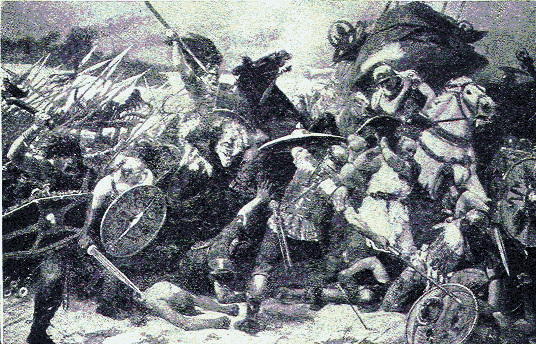
09 Vandals (East Germanic tribe) and Alans (group of Sarmatian tribes) crossed the Pyrenees and appear in Hispania (Iberian Peninsula, modern day Spain, Portugal, Andorra, and Gibraltar).

1307, on Friday the 13th, Hundreds of Knights Templar in France were simultaneously arrested by agents of Phillip the Fair, and were later tortured into a confession of heresy.

1399 Henry IV of England was crowned.


54 Emperor Claudius died from poison given him by his physician Xenophon and his empress Agrippina, and Nero became emperor of Rome. 4

09 Vandals (East Germanic tribe) and Alans (group of Sarmatian tribes) crossed the Pyrenees and appear in Hispania (Iberian Peninsula, modern day Spain, Portugal, Andorra, and Gibraltar).

1307, on Friday the 13th, Hundreds of Knights Templar in France were simultaneously arrested by agents of Phillip the Fair, and were later tortured into a confession of heresy.

1399 Henry IV of England was crowned.

Published on October 13, 2014 05:34
October 12, 2014
History Trivia - King John of England loses the crown jewels in The Wash
October 12

632 Edwin of Deira, King of Northumbria and Bretwalda died.

1216 King John of England lost the crown jewels in The Wash, possibly near Fosdyke or near Sutton Bridge.

1428 the Siege of Orleans began which lasted until Joan of Arc persuaded King Charles VII of France to send an army to relieve the city in April.
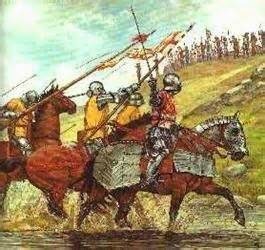
1459 Battle at Ludfor Bridge- Richard of York defeated.

1537 King Edward VI was born; he was the only son of Henry VIII and Jane Seymour (third wife); he became King at the age of 9 and died in his early teens.


632 Edwin of Deira, King of Northumbria and Bretwalda died.

1216 King John of England lost the crown jewels in The Wash, possibly near Fosdyke or near Sutton Bridge.

1428 the Siege of Orleans began which lasted until Joan of Arc persuaded King Charles VII of France to send an army to relieve the city in April.

1459 Battle at Ludfor Bridge- Richard of York defeated.

1537 King Edward VI was born; he was the only son of Henry VIII and Jane Seymour (third wife); he became King at the age of 9 and died in his early teens.

Published on October 12, 2014 05:26
October 11, 2014
History Trivia - Battle of Tours - Charles Martel defeats the Moors
October 11

732 Battle of Tours: Near Poitiers, France, the leader of the Franks, Charles Martel and his men, defeated a large army of Moors, stopping the Muslims from spreading into Western Europe. The governor of Cordoba, Abdul Rahman Al Ghafiqi, was killed during the battle
1
 303 Pope Boniface VIII died. He instituted the first Jubilee (special year of remission of sins and universal pardon).
303 Pope Boniface VIII died. He instituted the first Jubilee (special year of remission of sins and universal pardon).

1521 Pope Leo X granted Henry VIII the title Defender of the Faith for a tract defending Catholicism.

1542 Thomas Wyatt died. The English lyrical poet is credited with introducing the sonnet into English.


732 Battle of Tours: Near Poitiers, France, the leader of the Franks, Charles Martel and his men, defeated a large army of Moors, stopping the Muslims from spreading into Western Europe. The governor of Cordoba, Abdul Rahman Al Ghafiqi, was killed during the battle
1
 303 Pope Boniface VIII died. He instituted the first Jubilee (special year of remission of sins and universal pardon).
303 Pope Boniface VIII died. He instituted the first Jubilee (special year of remission of sins and universal pardon). 
1521 Pope Leo X granted Henry VIII the title Defender of the Faith for a tract defending Catholicism.

1542 Thomas Wyatt died. The English lyrical poet is credited with introducing the sonnet into English.

Published on October 11, 2014 06:03
October 10, 2014
Haiti shipwreck is not Columbus’s Santa Maria, says Unesco
UN researchers find proof that wreck initially believed to have been explorer’s flagship is actually from later period
 Painting of the Santa Maria, part of the fleet of Christopher Columbus. Photograph: Bettmann/Corbis
Painting of the Santa Maria, part of the fleet of Christopher Columbus. Photograph: Bettmann/Corbis
Claims that a wreck found off Haiti was Christopher Columbus’s flagship from his first voyage to the Americas have been scuttled after experts determined it was that of a ship from a later period.
The marine archaeologist Barry Clifford announced in May that he believed he had identified the wreck of the Santa Maria (video), one of three ships Columbus led on his first crossing of the Atlantic, which sank in 1492 off the northern coast of Haiti.
The UN cultural body Unesco dispatched a team of experts to the wreck, located off the town of Cap-Haitien, to examine the remains, which were found in the area where Columbus said the ship ran aground.
“There is now indisputable proof that the wreck is that of a ship from a much later period,” Unesco said on Monday.
“Although the site is located in the general area where one would expect to find the Santa Maria based on contemporary accounts of Columbus’s first voyage, it is further away from shore than one should expect,” experts said in a final report.
“Furthermore, and even more conclusively, the fasteners found on the site indicate a technique of ship construction that dates the ship to the late 17th or 18th century rather than the 15th or 16th century.”
They said an artefact recovered on site could be the remains of protective copper sheathing, and if it was, then “the ship could even not be dated to a time before the late 18th century”.
Columbus set sail on 3 August 1492 from Palos de la Frontera in southern Spain, with the Santa Maria, La Niña and La Pinta, searching for a shortcut to Asia. On 12 October of that year, he is believed to have landed in Guanahani, which historians have identified as an island in the Bahamas, in what is popularly called the “Discovery of the Americas”.
Columbus stopped in Cuba, and then Hispaniola – home to modern-day Haiti and the Dominican Republic – before the Santa Maria hit a reef and went down on 25 December 1492. The Spaniards built a fort near where the ship went down and then Columbus headed back to Spain to report to Queen Isabella on his trip. By the time he returned the next year, the fort had been burned down, and the crew left behind had died or disappeared.
The Unesco report said it was possible that, due to heavy sedimentation along the coast from rivers, the wreck had been buried over the past centuries. “The ship may also, however, have been slowly worn down by the waves, potentially leaving remains on a reef or sandbank in the bay,” it said, adding that Clifford had probably announced his discovery based on this second theory.
Unesco called for more exploration in the area, which was subject to heavy shipping traffic for centuries, to try to find the Santa Maria and draw up an inventory of other major wrecks there. It also called on Haiti – one of the world’s poorest countries – to enhance protection of its underwater heritage, which has been hit by looting.
The Guardian

 Painting of the Santa Maria, part of the fleet of Christopher Columbus. Photograph: Bettmann/Corbis
Painting of the Santa Maria, part of the fleet of Christopher Columbus. Photograph: Bettmann/Corbis Claims that a wreck found off Haiti was Christopher Columbus’s flagship from his first voyage to the Americas have been scuttled after experts determined it was that of a ship from a later period.
The marine archaeologist Barry Clifford announced in May that he believed he had identified the wreck of the Santa Maria (video), one of three ships Columbus led on his first crossing of the Atlantic, which sank in 1492 off the northern coast of Haiti.
The UN cultural body Unesco dispatched a team of experts to the wreck, located off the town of Cap-Haitien, to examine the remains, which were found in the area where Columbus said the ship ran aground.
“There is now indisputable proof that the wreck is that of a ship from a much later period,” Unesco said on Monday.
“Although the site is located in the general area where one would expect to find the Santa Maria based on contemporary accounts of Columbus’s first voyage, it is further away from shore than one should expect,” experts said in a final report.
“Furthermore, and even more conclusively, the fasteners found on the site indicate a technique of ship construction that dates the ship to the late 17th or 18th century rather than the 15th or 16th century.”
They said an artefact recovered on site could be the remains of protective copper sheathing, and if it was, then “the ship could even not be dated to a time before the late 18th century”.
Columbus set sail on 3 August 1492 from Palos de la Frontera in southern Spain, with the Santa Maria, La Niña and La Pinta, searching for a shortcut to Asia. On 12 October of that year, he is believed to have landed in Guanahani, which historians have identified as an island in the Bahamas, in what is popularly called the “Discovery of the Americas”.
Columbus stopped in Cuba, and then Hispaniola – home to modern-day Haiti and the Dominican Republic – before the Santa Maria hit a reef and went down on 25 December 1492. The Spaniards built a fort near where the ship went down and then Columbus headed back to Spain to report to Queen Isabella on his trip. By the time he returned the next year, the fort had been burned down, and the crew left behind had died or disappeared.
The Unesco report said it was possible that, due to heavy sedimentation along the coast from rivers, the wreck had been buried over the past centuries. “The ship may also, however, have been slowly worn down by the waves, potentially leaving remains on a reef or sandbank in the bay,” it said, adding that Clifford had probably announced his discovery based on this second theory.
Unesco called for more exploration in the area, which was subject to heavy shipping traffic for centuries, to try to find the Santa Maria and draw up an inventory of other major wrecks there. It also called on Haiti – one of the world’s poorest countries – to enhance protection of its underwater heritage, which has been hit by looting.
The Guardian

Published on October 10, 2014 15:21
In search of archaeological wonders Birchen Edge, Derbyshire
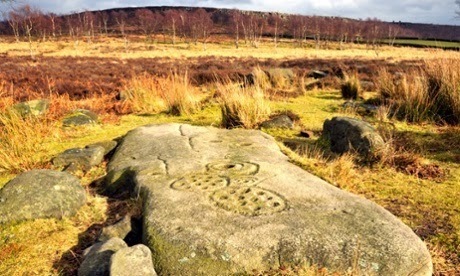 Gardom Edge’s cup and ring Neolithic carving, discovered in the 1960s, was reburied to preserve it, but the fibreglass replica is easy to find
Gardom Edge’s cup and ring Neolithic carving, discovered in the 1960s, was reburied to preserve it, but the fibreglass replica is easy to findEd Douglas
A replica rock carving on Gardom’s Edge. Photograph: Roy Childs/Alamy
The moorland and birch scrub between Gardom’s and Birchen Edge is smothered in archaeological wonders – cairns, field systems, tumuli – but they’re often hard to locate, either in time or space.
The unusually large enclosure known locally as Meg’s Wall, exposed and first documented after an intense moorland fire in the middle of the last century, has been described, variously, as a British defence wall from around the Roman period and a Neolithic ceremonial enclosure dated more recently as bronze age.
Gardom’s famous cup and ring Neolithic carving, discovered in the 1960s, was reburied to preserve it from weathering and damage. At least the fibreglass replica installed above the crag is easy to find. Other sites reveal how the Ordnance Survey, while remarkable, can be fallible. A bronze age ring cairn below Gardom’s is farther west than the map suggests; the wayside marker at Whibbersley Cross is on the wrong side of Clodhall Lane.
A few sites are plain baffling, such as the tumulus I am standing on now, east of Birchen’s. It lies concealed under a cloak of tall bracken, which has so far resisted the cold nights and dry weather. Otherwise the signs of autumn are all around, the yellowing grass and birch leaves, the weak pink of fading heather and wreaths of mist close to the ground punctured by the sudden rise of a meadow pipit.
The greatest pleasure, and one I draw deep into my lungs, is the crisp, cold air. Walking north to higher ground, the moors spread around me. I can look across to White Edge and Big Moor. In the bright sunshine, the Eagle Stone leaps out from the moors behind Baslow Edge, which drop in shallow arcs to the valley that cradles Gardom’s and all its inhabitants, past and present, in its arm.
Where I stand is a jumble of large stones, seemingly dug from the ground. They’re less weathered than more familiar remains and for a moment I’m puzzled. Then I spot the fluorescent orange tip of a marker wand. There’s a gas pipeline below my feet. And like a Nazca line, a ruler-straight stripe of paler grass leads east towards the rising sun.
The Guardian

Published on October 10, 2014 15:03
If great architecture belongs to humanity, do we have a responsibility to save it in wartimes?
Jeff Sparrow

A statue is on display in the Assyrian hall of Baghdad’s National Museum in 2005. Photograph: Charles Onians/AFP/Getty
The lands of Syria and Iraq gave rise to some the oldest societies we know: the Sumerians, the Akkadians, the Babylonians, the Assyrians, the Parthians, the Romans and many others. Traces of all of these peoples remain in archeological sites of the utmost significance.
And now they’re being destroyed.
A fortnight ago, satellite imagery revealed the cultural effects of Syria’s civil war. “The buildings of Aleppo, one of the oldest continuously inhabited cities in the world, has suffered extensive damage,” explained Archaeology magazine. “The ancient city of Bosra, the ancient site of Palmyra, the ancient villages of Northern Syria, and the castles Crac des Chevaliers and Qal’at Salah El-Din have all been damaged by mortar impacts and military activity.”
So too in Iraq.
Sometimes, the destruction is accidental (if that term means anything in wartime). Sometimes it’s deliberate, with the Islamic State systematically leveling ancient religious sites.
After looters rampaged through Baghdad’s National Museum in 2003, Francis Deblauwe established the (now defunct) Iraq and Archaeology site, which eloquently expresses what’s now once again happening. He wrote:
Iraq takes its name from Uruk, the ancient city said to have been ruled by Gilgamesh, sometime between 2,500 and 2,700 BC.
In the epic poem that bears his name, Gilgamesh leaves Uruk, a place he constructed, stricken with grief after the death of his friend. After many adventures, he accepts that only the gods endure forever, and returns with a new appreciation of the city – a human achievement that offers the only immortality humans can expect.
David Ferry’s beautiful translation describes Uruk as follows: A beheaded looted sculpture in Iraq’s archeological museum in Baghdad. Photograph: Patrick Baz/AFP/Getty
A beheaded looted sculpture in Iraq’s archeological museum in Baghdad. Photograph: Patrick Baz/AFP/Getty
The ancient stones exemplify the persistence of our collective culture, a persistence that provides, as the poem suggests, our sole consolation for the inescapability of our individual deaths. That’s why, in The Seven Lamps of Architecture, the great Victorian art critic John Ruskin argues that we have a responsibility to such artefacts. He warns:
But can we – or, rather, should we – proclaim the rights of the dead when patently we cannot guarantee the rights of the living?***
Nearly 200,000 people have already perished in Syria’s civil war. Estimates of deaths from the 2003 Iraq invasion vary from several hundred thousand to over a million, depending on which source you cite. In the midst of almost unimaginable blood and suffering, is it wrong to care about the walls of Uruk?
“I wish to be absolutely clear,” writes Deblauwe, “no epic Sumerian cuneiform tablet, majestic Neo-Assyrian lamassu sculpture or any other Mesopotamian artifact is worth a human life, be it Iraqi, American, British or other.”
The bluntness of that statement, from a man who palpably cares about Sumerian cuneiform tablets, contrasts with the abstraction of Ruskin’s formulation, which champions a generalised humanity over the flesh and blood of today’s people. Call it the antiquarian temptation: a tendency to privilege a bygone world over the one in which we actually live.
There’s a long, disreputable tradition of venerating ancient Rome and Greece while denigrating anyone with the temerity to live in those cities today. When ideologues seized cultural treasures from subaltern populations, they generally did so on the basis that the ignorant locals couldn’t appreciate the stuff’s value. That’s how major British museums built their collections, from the Elgin Marbles to the bones of Aboriginal people.
Yet it’s worth thinking about the perceived need for such expropriation.
*** An Afghan man rids his bicycle in front of the empty seat of the Buddha destroyed by the Taliban. Photograph: Shah Marai/AFP/Getty Why did the Taliban dynamite the Bamiyan buddhas? Like all despots, Mullah Omar and his men made the past into a guarantor of the future. The giant statues represented an alternative system of thought. By blasting away the ancient sculptures, the Taliban proclaimed, “there are no choices here – and there never have been.”
An Afghan man rids his bicycle in front of the empty seat of the Buddha destroyed by the Taliban. Photograph: Shah Marai/AFP/Getty Why did the Taliban dynamite the Bamiyan buddhas? Like all despots, Mullah Omar and his men made the past into a guarantor of the future. The giant statues represented an alternative system of thought. By blasting away the ancient sculptures, the Taliban proclaimed, “there are no choices here – and there never have been.”
The absorption of other civilisations’ treasures into the British empire spoke to the same need. Consider the incorporation of the diamond known as the Koh-i-Noor into the crown of Queen Elizabeth, an obvious and ostentatious demonstration of Britain’s power over India.
Likewise, settler societies such as Australia have always needed to denigrate the achievements of those they displaced, so as to justify the fiction of terra nullius. It’s a process that continues today. Some archaeologists calls the Brewarrina Fish Traps the oldest human constructions in the world – but how many white Australians have even heard of them?
In 1258, Genghis Khan sacked Baghdad, and systematically annihilated its famous House of Wisdom, the first ever university. “It was so horrible there are no words to describe it,” wrote the Persian poet Saadi of Shiraz. “I wish I had died earlier and not seen how these fools destroyed these treasures of knowledge and learning. I thought I understood the world but this holocaust is so strange and pointless I am struck dumb.”
In her book The Shock Doctrine, Naomi Klein records remarkably similar responses to the plunder of the National Museum of Iraq after the US invasion. “It was the soul of Iraq,” said one local merchant. “If the museum doesn’t recover the looted treasures, I will feel like a part of my own soul has been stolen.” “Baghdad is the mother of Arab culture,” said another man, “and they want to wipe out our culture.”
I wish I had died. My own soul has been stolen. Can we truly assert that no cultural artifact’s worth a human life?
Of course, the question’s unanswerable, since valuing the irreplaceable (whether a person or an artwork) constitutes, almost by definition, a category error. Nonetheless, it’s clear that the past and its culture cannot be so easily disentangled from the present and its politics. a Buddha head can be seen from the Mes Aynak archaeology site. Photograph: MCT/Getty Images Klein explains the pillage of Baghdad’s museum in terms of the neoconservative attempts to reconstruct Iraq as a deregulated, free market utopia. She quotes the coalition economic advisor Peter McPherson, who saw looting as a DIY privatisation, a legitimate beginning to the downsizing of state assets. “I thought the privatisation that occurs sort of naturally when somebody took over their state vehicle, or began to drive a truck that the state used to own, was just fine,” McPherson explained.
a Buddha head can be seen from the Mes Aynak archaeology site. Photograph: MCT/Getty Images Klein explains the pillage of Baghdad’s museum in terms of the neoconservative attempts to reconstruct Iraq as a deregulated, free market utopia. She quotes the coalition economic advisor Peter McPherson, who saw looting as a DIY privatisation, a legitimate beginning to the downsizing of state assets. “I thought the privatisation that occurs sort of naturally when somebody took over their state vehicle, or began to drive a truck that the state used to own, was just fine,” McPherson explained.
How can you protect a common human heritage when you’re innately opposed to collectivity? More importantly, why would you even try?
***
In the New York Times, Ziauddin Sardar discussed the historical destruction taking place taking in Mecca, where ancient sites have been crudely bulldozed by developers.
“The house of Khadijah, the first wife of the Prophet Muhammad, has been turned into a block of toilets,” he says. “The Makkah Hilton is built over the house of Abu Bakr, the closest companion of the prophet and the first caliph.”
Like the Islamic State militants they fund, the Saudi Salafists despise alternative interpretations of Islam. It’s common to call their philosophy “medieval”, but the label misrepresents the entirely 21st phenomenon taking place in Mecca. As Sardar argues, the Saudis have turned the “spiritual heart of Islam [into] an ultramodern, monolithic enclave, where difference is not tolerated, history has no meaning, and consumerism is paramount.”
The same might be said of the Islamic State itself. Its supporters raze ancient sites, not only to wipe out the traditions they represent, but also to capitalise on the thriving market for antiquities in the west, reportedly raising US$36m alone from the looting of al-Nabuk in Syria.
On the surface, the rich cosmopolitans who buy the stuff and the ascetic fundamentalists who steal it could not be more different. But they share an identical indifference to history as a collective resource for humanity. Do we need, then, a team of George Clooney-style “Monuments Men”, specially trained to guide the US forces in Iraq and minimise the historical damage they cause?
In 2009, the archeologist Yannis Hamilakis wrote a stinging rebuke to colleagues embedding with western militaries, arguing that they simply legitimised the destruction they sought to forestall. He quoted the Iraqi-born academic Zainab Bahrani: “The entirety of Iraq is a world cultural heritage site, and there is no way that a strategic bombing can avoid something archaeological.”
Just as recent “humanitarian” interventions in Afghanistan, Iraq or Libya have culminated in humanitarian catastrophes, efforts by what Hamilikis dubs “the military-archaeology complex” are unlikely to succeed, since long-term preservation depends upon a relationship between the history of a site and those who inhabit it today.
The great poet and designer William Morris argued something similar during his campaign to spare the ancient buildings of Britain from the ravages of industrialisation.“Believe me,” he explained to supporters, “it will not be possible for a small knot of cultivated people to keep alive an interest in the art and records of the past amidst the present conditions of a sordid and heart-breaking struggle for existence for the many, and a languid sauntering through life for the few.”
On another occasion, he put it like this: “If we have no hope for the future, I do not see how we can look back on the past with pleasure.”
The same might be said about Iraq and Syria today. The fight for our collective heritage necessarily involves a struggle for peace and social justice, for it’s only when people feel a stake in the world around them that they can appreciate the achievements of the ancients as part of their lives.
The Guardian


A statue is on display in the Assyrian hall of Baghdad’s National Museum in 2005. Photograph: Charles Onians/AFP/Getty
The lands of Syria and Iraq gave rise to some the oldest societies we know: the Sumerians, the Akkadians, the Babylonians, the Assyrians, the Parthians, the Romans and many others. Traces of all of these peoples remain in archeological sites of the utmost significance.
And now they’re being destroyed.
A fortnight ago, satellite imagery revealed the cultural effects of Syria’s civil war. “The buildings of Aleppo, one of the oldest continuously inhabited cities in the world, has suffered extensive damage,” explained Archaeology magazine. “The ancient city of Bosra, the ancient site of Palmyra, the ancient villages of Northern Syria, and the castles Crac des Chevaliers and Qal’at Salah El-Din have all been damaged by mortar impacts and military activity.”
So too in Iraq.
Sometimes, the destruction is accidental (if that term means anything in wartime). Sometimes it’s deliberate, with the Islamic State systematically leveling ancient religious sites.
After looters rampaged through Baghdad’s National Museum in 2003, Francis Deblauwe established the (now defunct) Iraq and Archaeology site, which eloquently expresses what’s now once again happening. He wrote:
War in this cradle of civilization beyond the horrendous, almost invisible casualties – always somebody’s husband, always somebody’s son – and downplayed ‘collateral damage’ – always somebody’s wife, always somebody’s child – inevitably takes its toll on the archaeological heritage as well. After all, this fertile flood plain and surrounding mountains gave birth to agriculture, to writing, to cities, to laws, to the 24 hours in a day, and many more things we take for granted.***
Iraq takes its name from Uruk, the ancient city said to have been ruled by Gilgamesh, sometime between 2,500 and 2,700 BC.
In the epic poem that bears his name, Gilgamesh leaves Uruk, a place he constructed, stricken with grief after the death of his friend. After many adventures, he accepts that only the gods endure forever, and returns with a new appreciation of the city – a human achievement that offers the only immortality humans can expect.
David Ferry’s beautiful translation describes Uruk as follows:
 A beheaded looted sculpture in Iraq’s archeological museum in Baghdad. Photograph: Patrick Baz/AFP/Getty
A beheaded looted sculpture in Iraq’s archeological museum in Baghdad. Photograph: Patrick Baz/AFP/Getty The outer wallUruk’s ruins were rediscovered in the 19th century, 250kms south of Baghdad. That means we can, quite literally, study the brickwork and the fortifications and the outer walls upon which Gilgamesh once gazed – and when we do, we confront the same questions about eternity and loss he pondered some 4,500 years earlier.
shines in the sun like brightest copper; the inner
wall is beyond the imagining of kings.
Study the brickwork, study the fortification;
climb the great ancient staircase to the terrace;
study how it is made…
The ancient stones exemplify the persistence of our collective culture, a persistence that provides, as the poem suggests, our sole consolation for the inescapability of our individual deaths. That’s why, in The Seven Lamps of Architecture, the great Victorian art critic John Ruskin argues that we have a responsibility to such artefacts. He warns:
They are not ours. They belong partly to those who built them, and partly to all the generations of mankind who are to follow us. The dead have still their right in them: that which they labored for, the praise of achievement or the expression of religious feeling, or whatsoever else it might be which in those buildings they intended to be permanent, we have no right to obliterate.Great architecture, Ruskin says, belongs to humanity as a whole, and not to “those mobs who do violence to it”. It’s an argument that surely applies to the relics of ancient Mesopotamia, caught between Islamic State fighters and US strike bombers.
But can we – or, rather, should we – proclaim the rights of the dead when patently we cannot guarantee the rights of the living?***
Nearly 200,000 people have already perished in Syria’s civil war. Estimates of deaths from the 2003 Iraq invasion vary from several hundred thousand to over a million, depending on which source you cite. In the midst of almost unimaginable blood and suffering, is it wrong to care about the walls of Uruk?
“I wish to be absolutely clear,” writes Deblauwe, “no epic Sumerian cuneiform tablet, majestic Neo-Assyrian lamassu sculpture or any other Mesopotamian artifact is worth a human life, be it Iraqi, American, British or other.”
The bluntness of that statement, from a man who palpably cares about Sumerian cuneiform tablets, contrasts with the abstraction of Ruskin’s formulation, which champions a generalised humanity over the flesh and blood of today’s people. Call it the antiquarian temptation: a tendency to privilege a bygone world over the one in which we actually live.
There’s a long, disreputable tradition of venerating ancient Rome and Greece while denigrating anyone with the temerity to live in those cities today. When ideologues seized cultural treasures from subaltern populations, they generally did so on the basis that the ignorant locals couldn’t appreciate the stuff’s value. That’s how major British museums built their collections, from the Elgin Marbles to the bones of Aboriginal people.
Yet it’s worth thinking about the perceived need for such expropriation.
***
 An Afghan man rids his bicycle in front of the empty seat of the Buddha destroyed by the Taliban. Photograph: Shah Marai/AFP/Getty Why did the Taliban dynamite the Bamiyan buddhas? Like all despots, Mullah Omar and his men made the past into a guarantor of the future. The giant statues represented an alternative system of thought. By blasting away the ancient sculptures, the Taliban proclaimed, “there are no choices here – and there never have been.”
An Afghan man rids his bicycle in front of the empty seat of the Buddha destroyed by the Taliban. Photograph: Shah Marai/AFP/Getty Why did the Taliban dynamite the Bamiyan buddhas? Like all despots, Mullah Omar and his men made the past into a guarantor of the future. The giant statues represented an alternative system of thought. By blasting away the ancient sculptures, the Taliban proclaimed, “there are no choices here – and there never have been.”The absorption of other civilisations’ treasures into the British empire spoke to the same need. Consider the incorporation of the diamond known as the Koh-i-Noor into the crown of Queen Elizabeth, an obvious and ostentatious demonstration of Britain’s power over India.
Likewise, settler societies such as Australia have always needed to denigrate the achievements of those they displaced, so as to justify the fiction of terra nullius. It’s a process that continues today. Some archaeologists calls the Brewarrina Fish Traps the oldest human constructions in the world – but how many white Australians have even heard of them?
In 1258, Genghis Khan sacked Baghdad, and systematically annihilated its famous House of Wisdom, the first ever university. “It was so horrible there are no words to describe it,” wrote the Persian poet Saadi of Shiraz. “I wish I had died earlier and not seen how these fools destroyed these treasures of knowledge and learning. I thought I understood the world but this holocaust is so strange and pointless I am struck dumb.”
In her book The Shock Doctrine, Naomi Klein records remarkably similar responses to the plunder of the National Museum of Iraq after the US invasion. “It was the soul of Iraq,” said one local merchant. “If the museum doesn’t recover the looted treasures, I will feel like a part of my own soul has been stolen.” “Baghdad is the mother of Arab culture,” said another man, “and they want to wipe out our culture.”
I wish I had died. My own soul has been stolen. Can we truly assert that no cultural artifact’s worth a human life?
Of course, the question’s unanswerable, since valuing the irreplaceable (whether a person or an artwork) constitutes, almost by definition, a category error. Nonetheless, it’s clear that the past and its culture cannot be so easily disentangled from the present and its politics.
 a Buddha head can be seen from the Mes Aynak archaeology site. Photograph: MCT/Getty Images Klein explains the pillage of Baghdad’s museum in terms of the neoconservative attempts to reconstruct Iraq as a deregulated, free market utopia. She quotes the coalition economic advisor Peter McPherson, who saw looting as a DIY privatisation, a legitimate beginning to the downsizing of state assets. “I thought the privatisation that occurs sort of naturally when somebody took over their state vehicle, or began to drive a truck that the state used to own, was just fine,” McPherson explained.
a Buddha head can be seen from the Mes Aynak archaeology site. Photograph: MCT/Getty Images Klein explains the pillage of Baghdad’s museum in terms of the neoconservative attempts to reconstruct Iraq as a deregulated, free market utopia. She quotes the coalition economic advisor Peter McPherson, who saw looting as a DIY privatisation, a legitimate beginning to the downsizing of state assets. “I thought the privatisation that occurs sort of naturally when somebody took over their state vehicle, or began to drive a truck that the state used to own, was just fine,” McPherson explained.How can you protect a common human heritage when you’re innately opposed to collectivity? More importantly, why would you even try?
***
In the New York Times, Ziauddin Sardar discussed the historical destruction taking place taking in Mecca, where ancient sites have been crudely bulldozed by developers.
“The house of Khadijah, the first wife of the Prophet Muhammad, has been turned into a block of toilets,” he says. “The Makkah Hilton is built over the house of Abu Bakr, the closest companion of the prophet and the first caliph.”
Like the Islamic State militants they fund, the Saudi Salafists despise alternative interpretations of Islam. It’s common to call their philosophy “medieval”, but the label misrepresents the entirely 21st phenomenon taking place in Mecca. As Sardar argues, the Saudis have turned the “spiritual heart of Islam [into] an ultramodern, monolithic enclave, where difference is not tolerated, history has no meaning, and consumerism is paramount.”
The same might be said of the Islamic State itself. Its supporters raze ancient sites, not only to wipe out the traditions they represent, but also to capitalise on the thriving market for antiquities in the west, reportedly raising US$36m alone from the looting of al-Nabuk in Syria.
On the surface, the rich cosmopolitans who buy the stuff and the ascetic fundamentalists who steal it could not be more different. But they share an identical indifference to history as a collective resource for humanity. Do we need, then, a team of George Clooney-style “Monuments Men”, specially trained to guide the US forces in Iraq and minimise the historical damage they cause?
In 2009, the archeologist Yannis Hamilakis wrote a stinging rebuke to colleagues embedding with western militaries, arguing that they simply legitimised the destruction they sought to forestall. He quoted the Iraqi-born academic Zainab Bahrani: “The entirety of Iraq is a world cultural heritage site, and there is no way that a strategic bombing can avoid something archaeological.”
Just as recent “humanitarian” interventions in Afghanistan, Iraq or Libya have culminated in humanitarian catastrophes, efforts by what Hamilikis dubs “the military-archaeology complex” are unlikely to succeed, since long-term preservation depends upon a relationship between the history of a site and those who inhabit it today.
The great poet and designer William Morris argued something similar during his campaign to spare the ancient buildings of Britain from the ravages of industrialisation.“Believe me,” he explained to supporters, “it will not be possible for a small knot of cultivated people to keep alive an interest in the art and records of the past amidst the present conditions of a sordid and heart-breaking struggle for existence for the many, and a languid sauntering through life for the few.”
On another occasion, he put it like this: “If we have no hope for the future, I do not see how we can look back on the past with pleasure.”
The same might be said about Iraq and Syria today. The fight for our collective heritage necessarily involves a struggle for peace and social justice, for it’s only when people feel a stake in the world around them that they can appreciate the achievements of the ancients as part of their lives.
The Guardian

Published on October 10, 2014 14:55
Scientists hope to unravel mystery of the ‘Titanic of the ancient world’
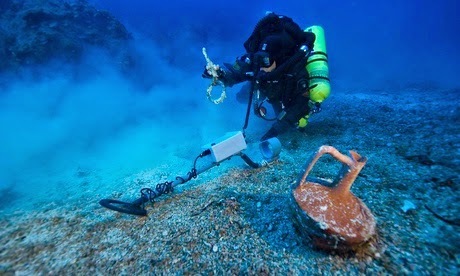 A diver approaches an almost intact pitcher at the site of the underwater exploration near Antikythera island in Greece. Photograph: EPA
A diver approaches an almost intact pitcher at the site of the underwater exploration near Antikythera island in Greece. Photograph: EPA They call it the Titanic of the ancient world – a luxury liner dating from before the Roman empire. Now divers and archeologists, who have completed a third season on this famous wreck off the remote Greek island of Antikythera, hope that their latest finds can at last help settle speculation surrounding the ship, its passengers and crew.
After mapping the treacherous site, the international team hope that a small but carefully selected haul of artefacts on the huge site more than 55 metres beneath the surface can help unravel the truth about a vessel that may have been 50 metres long.
The inner workings of the Antikythera mechanism.Antiquities rescued on this visit include an intact table jug, bronze ornamentation that was probably part of a bed, a 2-metre piece of a bronze spear, weighing more than 10kg and most probably part of a statue – perhaps of a warrior or the goddess Athena – and a bronze rigging ring with fragments of wood still attached.
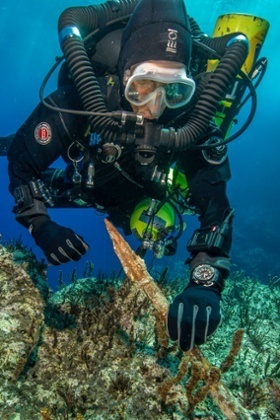 A diver holds a bronze spear at the site of the Antikythera wreck. Photograph: Brett Seymour/AP Scientists also plan to trace the origin of the lead in huge anchors and hull sheathing to help determine whether the ship was of Italian, Roman or Hellenic origin. And they want to check DNA in the ceramic jug, one of nearly 50 found by various explorations of the wreck dating back to 1900, to establish whether it was carrying grain. Grain and stone carriers were the biggest sea-going vessels more than 2,000 years ago.
A diver holds a bronze spear at the site of the Antikythera wreck. Photograph: Brett Seymour/AP Scientists also plan to trace the origin of the lead in huge anchors and hull sheathing to help determine whether the ship was of Italian, Roman or Hellenic origin. And they want to check DNA in the ceramic jug, one of nearly 50 found by various explorations of the wreck dating back to 1900, to establish whether it was carrying grain. Grain and stone carriers were the biggest sea-going vessels more than 2,000 years ago.Even the first finds, made by sponge divers blown off course well over a century ago, included spectacular treasures – including enormous statues, and the elaborate Antikythera mechanism, a complex early “computer”, tracking cycles of the solar system. Many of the artefacts are now in the National Archaeological Museum in Athens.
Examination of hull remains, recovered in 1976, suggest that the planks, 11cm thick even in a shrunken state, come from a ship that was 15-20% bigger than any wreck of similar age. The only wrecks that come close, according to Brendan Foley, of the Woods Hole Oceonographic Institution in Massachusetts, were the pleasure barges of the emperor Caligula discovered in Lake Nemi, Italy, in the 1920s and later destroyed in an allied bombing raid during the second world war.
“I have personally investigated 40 or 45 shipwrecks throughout the Mediterranean and never seen one like this. It is full of luxury goods. It is an enormous ship, massively built and built of the highest quality material available in the first century BC,” Foley said.
Among the stories built up around the wreck is that it may have carried a young bride and her dowry on her way to her wedding. But, Foley admitted, “we have no evidence of that. It is just a nice story we tell each other. A logical conclusion [of finds so far] is these are treasures, high-value goods travelling from the eastern Mediterranean, through the Aegean, to the growing centre [of Rome] but we don’t have actual proof of that.”
Foley said his team thought the jar was part of the cargo, rather than belonging to a member of the crew. “We are excited about its recovery because it was full of sediment so we can anlyse that, and once we get the sediment out, we can run our DNA swabs and find out what it was transporting.
 A diver wearing a robotic exosuit explores the site of the wreck called the Titanic of the ancient world. Photograph: Greek Ministry of Culture/EPA “Grain ships would sail out of Rome. They were the sort of first luxury liners. The wealthy would sail out in the spring, go to Egypt, tour the antiquities. Then at the end of the season, they would get back on board the ship with hundreds and hundreds of tons of grain to take back to Rome to feed the burgeoning population.”
A diver wearing a robotic exosuit explores the site of the wreck called the Titanic of the ancient world. Photograph: Greek Ministry of Culture/EPA “Grain ships would sail out of Rome. They were the sort of first luxury liners. The wealthy would sail out in the spring, go to Egypt, tour the antiquities. Then at the end of the season, they would get back on board the ship with hundreds and hundreds of tons of grain to take back to Rome to feed the burgeoning population.”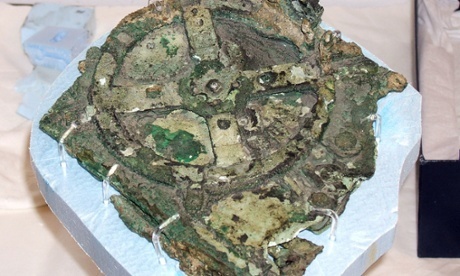 The Antikythera mechanism, a bronze device to tell the cycles of the stars, was recovered in 1900. Photograph: X-Tek Group/AFP The divers will be back next May and June hoping, among other things, to find more of the famous mechanism, of which only 50-60% is thought to have been recovered so far. They also hope they will not be hit by the bad weather they suffered this year, allowing just five days underwater and little use of a new diving suit that will allow divers to stay on the sea floor for hours without decompression problems.
The Antikythera mechanism, a bronze device to tell the cycles of the stars, was recovered in 1900. Photograph: X-Tek Group/AFP The divers will be back next May and June hoping, among other things, to find more of the famous mechanism, of which only 50-60% is thought to have been recovered so far. They also hope they will not be hit by the bad weather they suffered this year, allowing just five days underwater and little use of a new diving suit that will allow divers to stay on the sea floor for hours without decompression problems.Theotokis Theodoulou, of the Hellenic Ephorate of Underwater Antiquities, says this year’s finds were very promising. “We have a lot of work to do at this site to uncover its secrets.”
 Theotokis Theodoulou wears a revolutionary new deep sea diving suit to explore the ancient shipwreck. Photograph: Alex Deciccio/AFP/Getty ImagesThe Guardian
Theotokis Theodoulou wears a revolutionary new deep sea diving suit to explore the ancient shipwreck. Photograph: Alex Deciccio/AFP/Getty ImagesThe Guardian 
Published on October 10, 2014 14:45



